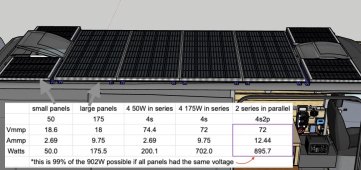I'm installing a 900W of solar on top of a van intended for "full-time" use. It will also have alternator-based charging, and maybe shorepower someday.
I want to buy lithium phosphate batteries, but need to decide how much. My goal is to operate "off-grid" as much as possible, and not have to worry if I decide I want power-hungry items in the future. I realize it might be overkill, but can someone explain what would be the disadvantage of buying 600Ah, or even 800Ah? Please avoid obvious things like cost and weight... I can figure that part out. Thanks
I've been looking at these from the mobile-solarpower.com site:
A) 2 of the EG4-LL Lithium Battery (12V 400AH) Server Rack Batteries or
B) 3 or 4 of the 12V 206Ah SOK Batteries
If you have actual experience, I'd find your advice especially helpful! Thanks
By the way, the figure below shows my setup, involving 4x50W panels and 4x175W panels, and a table for how I figured the 900W. It also shows my electrical panel, which is small right now because I only have the 4x50W panels so far.

I want to buy lithium phosphate batteries, but need to decide how much. My goal is to operate "off-grid" as much as possible, and not have to worry if I decide I want power-hungry items in the future. I realize it might be overkill, but can someone explain what would be the disadvantage of buying 600Ah, or even 800Ah? Please avoid obvious things like cost and weight... I can figure that part out. Thanks
I've been looking at these from the mobile-solarpower.com site:
A) 2 of the EG4-LL Lithium Battery (12V 400AH) Server Rack Batteries or
B) 3 or 4 of the 12V 206Ah SOK Batteries
If you have actual experience, I'd find your advice especially helpful! Thanks
By the way, the figure below shows my setup, involving 4x50W panels and 4x175W panels, and a table for how I figured the 900W. It also shows my electrical panel, which is small right now because I only have the 4x50W panels so far.

Last edited:


